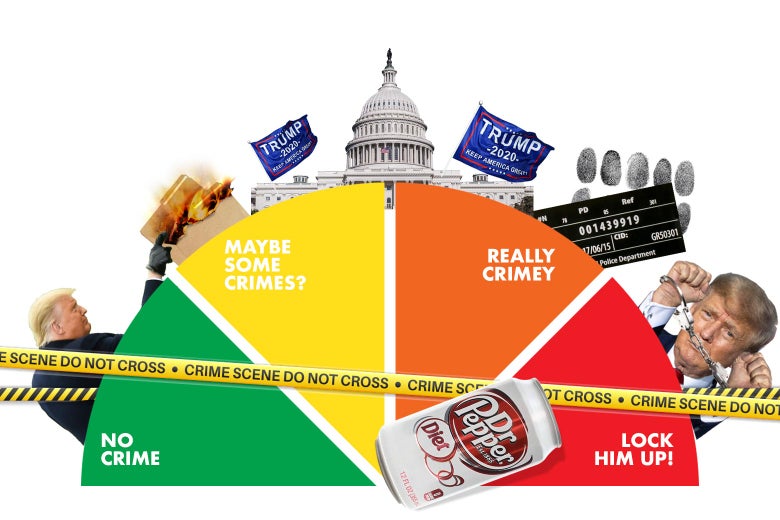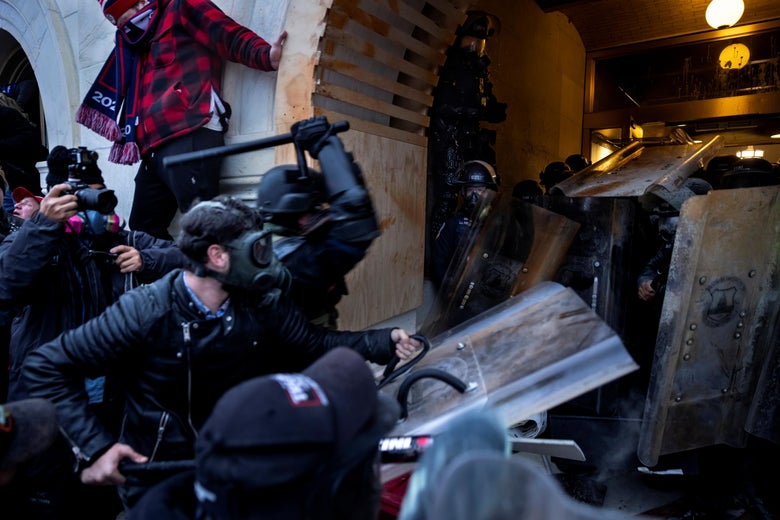In the tradition of the Clintonometer, the Trump Apocalypse Watch, and the Impeach-O-Meter, the Is It a Crime-O-Meter is a wildly subjective and speculative estimate of whether the Jan. 6 select committee’s work will convince enough individuals of relevance (prosecutors, juries, voters) that Donald Trump committed insurrection-related crimes that he will be, in some fashion, held accountable for them.
In March 2019, facing the looming results of a special counsel probe into possible crimes he had committed as president, Donald Trump laid out what he expected would happen if his position in the White House were ever seriously threatened in an interview with Breitbart News.
“I can tell you I have the support of the police, the support of the military, the support of the Bikers for Trump,” the president said, naming groups who shared in common a predilection for being armed. “I have the tough people, but they don’t play it tough—until they go to a certain point, and then it would be very bad, very bad.”
As I wrote at the time, implicit in those comments was the notion that if those armed supporters should ever feel his presidency was threatened, they would come to his rescue and bring their weapons. Trump famously nodded again to this sentiment during his lone televised debate with Joe Biden when he told the Proud Boys to “stand by” should he face defeat in the election.
Donald Trump did face defeat in the election—and the Proud Boys were central to the mob attack unleashed on the Capitol on Jan. 6.
That Trump knew his supporters would defend him with violence if necessary—as they did on Jan. 6—has been a running theme of the Jan. 6 committee’s summer hearings. Last month, Cassidy Hutchinson testified that she heard Trump demand that his armed supporters be let into the rally at the ellipse because “they’re not here to hurt me.” On Tuesday, the committee pressed this case that Trump knew—or certainly should have known—what his supporters might be capable of on Jan. 6. The committee is laying out the case that the violence unleashed on the Capitol that day was always part of the plan.
The biggest revelations of the day surrounded details of an “unhinged” Oval Office meeting between Trump, Gen. Michael Flynn, lawyer Sidney Powell, and former Overstock.com CEO Patrick M. Byrne, in which Trump may or may not have appointed Powell special counsel and reportedly considered a pitch for declaring martial law. My colleague Ben Mathis-Lilley wrote about Powell’s testimony—she described what was obviously a slightly unprecedented meeting incredibly casually as she coolly polished off a Diet Dr. Pepper in between answers.
But the outlandish theatrics of Trumpworld aside, what’s more interesting to today’s crime-o-meter is what came after that meeting: Lots of evidence that the risk of bloodshed was obvious at that point to seemingly everyone in a position of power in Washington D.C. Immediately following that reportedly alcohol-fueled midnight meeting, close to 2 a.m. on Dec. 19, Trump tweeted his now infamous call for supporters to come to the Capitol on Jan. 6 for a protest that “will be wild.”
The committee then laid out how a Voltron of violent right-wing radicals almost immediately came together, first with testimony from an anonymous former Twitter employee who was tasked with tracking it all. The Twitter employee noted that the call and response of Trump was quickly met:
It felt as if a mob was being organized and they were gathering together their weaponry and their logic and their reasoning behind why they were prepared to fight prior to Dec. 19. … Very clear that individuals were ready willing and able to take up arms. After this Tweet on Dec. 19, again it became clear not only were these individuals ready and willing, but the leader of their cause was asking them to join him.
The former Twitter employee also said he had seen a similar spike in dangerous responses on the platform after Trump’s 2020 debate call for the Proud Boys to “stand by.”
Also following Trump’s tweet, a Jan. 6 rally organizer immediately launched a web site with the url wildprotest.com. Many of President Trump’s other supporters online responded in other ways—some calling for mass executions and for protesters to bring “body armor, knuckles, shields, bats, pepper spray,” all of which were eventually brought to the Capitol and used against police that day.
Donell Harvin, chief of homeland security and intelligence for D.C., testified that disparate groups immediately came together to create a single deadly force descending on D.C.
“We got derogatory information from [open source intelligence] suggesting that some very, very violent individuals were organizing to come to D.C. But not only were they organizing to come to D.C.—these non-aligned groups were aligning,” Harvin said. “When you have armed militia collaborating with white supremacy groups collaborating with conspiracy theory groups online all towards a common goal, you start seeing what we call in terrorism a blended ideology and that’s a very, very bad sign.”
Indeed, central to these efforts were people like Ali Alexander and Alex Jones, whose rhetoric regularly became violent, on top of the militia groups of the Oathkeepers and Proud Boys that started organizing right away and whose leaders have since been charged with seditious conspiracy for their role in the Capitol invasion. So troubled by the presence of these sorts of elements was former Trump spokesperson and Jan. 6 rally organizer, Katrina Pierson, that she attempted to warn White House chief of staff Mark Meadows via text about how bad she expected things to get. On Jan. 2, she requested a call with Meadows, saying that with regards to the Jan. 6 planning: “Things have gotten crazy and I desperately need some direction. Please.” During the following call, she outlined her concerns to Meadows that Jones and Alexander were involved with a previous invasion of a state capitol in Georgia. This was the same day that Hutchinson testified that Meadows warned her that things might get “real, real bad on Jan. 6.”
It was also around this time that rally organizers were texting each other about secret plans for Trump to instruct rallygoers to march to the Capitol after his speech. The committee unveiled an undated draft Trump tweet in which he was set to let his supporters know that there would be a “March to the Capitol after” the ellipse rally. The tweet was never sent, but leaders of the rally were clearly given advance notice of the instruction, with the committee producing multiple text and email exchanges from different rallygoers describing how the president was going to instruct them to “unexpectedly” march to the Capitol. Notably, Trump also called and spoke with advisor Steve Bannon—who is about to go on trial for contempt of Congress following his refusal to cooperate with the committee—on the morning of Jan. 5, right before Bannon went on the air to tell his podcast listeners that “all hell is going to break loose tomorrow.” Bannon continued: “it’s not going to happen like you think it’s going to happen, it’s going to be quite extraordinarily different, and all I can say is strap in.” Oh, and also, on the eve of Jan. 6, Trump-supporting Rep. Debbie Lesko was recorded requesting a “safety plan for members” of Congress, because she knew “Trump supporters” were “going to go nuts” in the likely event that Congress did not “overturn the election.”
In sum: More than a year before Jan. 6 happened, Trump warned America that he could summon a mob of armed “tough people” at will to “go to a certain point, and then it would be very bad, very bad.” Then, in the midst of the 2020 campaign, he told a specific group of tough guys to “stand by” should he lose the election. Then, after all of his legal challenges collapsed and his White House counsel shut down the proposals of a bunch of loons that would involve Powell becoming special counsel and potentially martial law, Trump immediately called on those supporters to come to Washington for a “wild” protest. Then, militia groups that were body guards for two of Trump’s top former advisors—Michael Flynn and Roger Stone—began organizing for a descent on D.C. as internet chatter exploded with the potential for violence. At the same time, nearly everybody in Washington D.C. was fearful, or perhaps, expectant that this violence would erupt. Oh, and Trump was secretly planning at the time to send his supporters to the Capitol, and when they got to his rally, he wanted as many of them who were armed in attendance as possible because he knew he would not be the target of their violence.
I don’t know, seems pretty crime-y to me! The Diet Dr. Pepper can is pointing directly to a meter of FULL CRIME.

